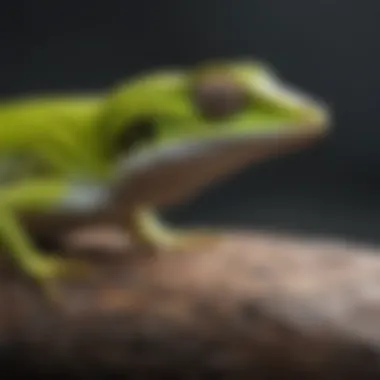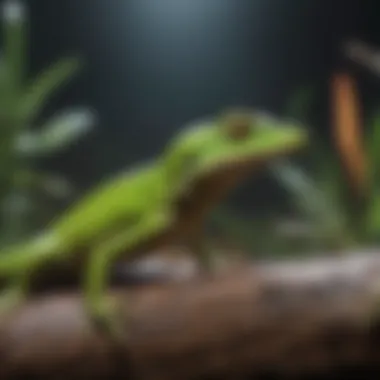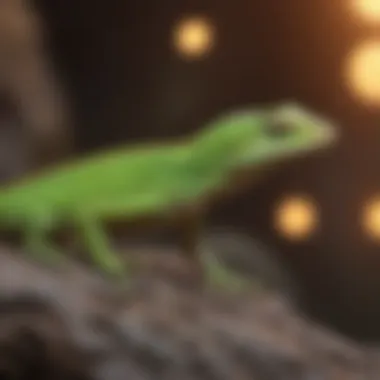Crafting the Perfect Anole Habitat: Your Comprehensive Tank Setup Guide


Pet Care Essentials
When it comes to caring for your anoles, ensuring their daily nutrition requirements are met is vital. Anoles thrive on a diet primarily composed of insects such as crickets, mealworms, and flies. It's essential to offer a varied diet to ensure they receive adequate nutrition. Equally important is providing them with opportunities for exercise and playtime. Anoles are active lizards that enjoy climbing, basking, and exploring their environment. Set up their tank with branches, rocks, and other climbing structures to encourage natural behaviors.
In terms of grooming, anoles don't require much maintenance. However, it's essential to regularly clean their tank to prevent bacteria build-up and keep them healthy. Health and wellness check-ins should also be a regular part of your routine. Monitor your anoles for any signs of illness, such as changes in appetite, behavior, or appearance. Consulting a veterinarian specializing in reptiles is advisable for any health concerns.
Behavior & Training
Understanding your anoles' body language is key to deciphering their emotions and needs. Anoles communicate through gestures, body posture, and color changes. They may contrast colors to display dominance or excitement. Basic training techniques can help establish a bond with your anoles. Rewarding positive behaviors reinforces good habits.
When it comes to behavioral concerns, anoles may exhibit stress or aggression if their environment is not suitable. Socialization tips involve creating a calm and secure environment for your anoles to thrive. Introducing new stimuli gradually can prevent stress and ensure their well-being.
Pet Home Environment
Creating a pet-friendly space for your anoles involves considering their natural habitat. Mimic a tropical environment with proper humidity levels and temperature. Safety measures are crucial to avoid hazards such as toxic plants or sharp objects in their tank.
Choosing the right toys and accessories enhances their environment. Items like foliage, climbing structures, and hiding spots cater to their natural instincts. Setting up a comfortable resting area with soft substrates encourages relaxation and reduces stress.
Pet Health Issues
Recognizing signs of illness in anoles is essential for prompt intervention. Symptoms like lethargy, weight loss, or abnormal skin conditions may indicate health issues. Preventative care measures include regular tank cleaning, maintaining optimal humidity, and providing a balanced diet.
Understanding common ailments like metabolic bone disease or respiratory infections equips you to address health issues effectively. Emergency preparedness involves having a reptile-friendly first aid kit on hand in case of unexpected emergencies. Prompt veterinary care is crucial for addressing any health concerns promptly.
Introduction
In the realm of caring for exotic pets, setting up a proper habitat plays a crucial role in ensuring the well-being and longevity of the animal residents, and anoles, with their delicate nature, certainly require meticulous attention to detail. This article embarks on a journey to unveil the intricate process of establishing an anole tank, serving as a beacon of knowledge for both novice pet owners and seasoned reptile enthusiasts. The establishment of an ideal anole tank environment is not just a mere task but a significant responsibility that demands careful planning and execution. From providing the right tank size to mimicking their natural habitat through precise lighting and temperature settings, every facet of anole tank setup contributes to the overall health and contentment of these enchanting creatures. Therefore, delving into the nuances of creating a suitable anole abode is not only a fulfilling endeavor but a gateway to fostering a thriving ecosystem within your living space.
Understanding Anoles


An integral aspect of setting up an anole tank is comprehending the intricate nature of anoles themselves. Understanding their behavior, habitats, and species-specific requirements is crucial for creating an optimal tank environment. By gaining insights into anoles, enthusiasts can cater effectively to their needs, fostering a healthy and comfortable living space. This section delves deep into various crucial elements that define anoles, offering a foundation for the subsequent tank setup guidelines.
Species Overview
Anoles belong to the family Dactyloidae, encompassing hundreds of species scattered across diverse habitats. Commonly found in the Americas, anoles exhibit remarkable variations in size, coloration, and behavior according to their species. Some popular species include the green anole (Anolis carolinensis) and the knight anole (Anolis equestris), each possessing unique characteristics that influence their care requirements within a captive environment.
Behavioral Traits
Anoles are known for their arboreal lifestyle, preferring to dwell in the canopy of trees and bushes. They exhibit territorial behavior, often engaging in visual displays and head-bobbing to assert dominance or attract mates. Understanding their territorial instincts and social dynamics is essential for creating a stress-free environment within the tank. Behavioral observations can help identify signs of distress or illness, enabling timely interventions to preserve the well-being of the anoles.
Habitat Requirements
Anoles thrive in tropical environments characterized by moderate temperatures, high humidity levels, and ample vegetation for climbing and basking. Mimicking their natural habitat within the tank is imperative for their health and happiness. Providing suitable hiding spots, branches for climbing, and a thermal gradient ensures that the anoles can regulate their body temperature efficiently. Attention to detail in replicating their native habitat guarantees a comfortable and enriching environment for these captivating reptiles.
Selecting the Right Tank
Selecting the right tank is a crucial step in creating an optimal habitat for your anole companions. The size, material, and ventilation of the tank play vital roles in the well-being and comfort of these reptiles. Proper consideration of these factors is essential to ensure a healthy and thriving environment for your anoles.
Tank Size Guidelines
When it comes to tank size for anoles, the basic rule is the larger, the better. Anoles require space to move around, climb, and explore. A tank size of at least 20 gallons is recommended for a pair of anoles to provide ample space for their physical and mental stimulation. It is important to factor in the size of the anoles, as well as any decor and hiding spots within the tank when determining the appropriate tank size.
Material Considerations
The material of the tank can impact the overall well-being of your anoles. Opt for tanks made of glass or PVC as they provide good insulation and are easy to clean. Glass tanks are durable and offer better visibility into the enclosure, allowing you to observe your anoles easily. PVC tanks are lightweight and retain heat well, creating a comfortable environment for your pets.
Ventilation Needs
Proper ventilation is essential to maintain air quality and regulate humidity levels within the tank. Ensure the tank has adequate ventilation to prevent the buildup of moisture, which can lead to respiratory issues for your anoles. Mesh screen tops or vents on the sides of the tank can help promote air circulation while preventing escapes. Regularly check and clean the ventilation openings to ensure optimum airflow for your anole's health and well-being.


Setting Up the Tank Environment
In the realm of creating a suitable habitat for anoles, the task of setting up the tank environment stands as a pivotal undertaking. This component encapsulates a myriad of crucial elements that collectively contribute to the well-being and comfort of these reptiles in captivity. As meticulous caretakers of anoles, it is imperative to pay meticulous attention to the details of this phase to ensure the optimal conditions for their existence.
Substrate Selection
When it comes to substrate selection for anoles, one must delve into the intricacies of material composition, particle size, and hygienic properties. The substrate serves as the foundation for the tank environment, mimicking the natural terrain of anoles' native habitats. Opting for substrates devoid of chemicals or toxins is paramount to prevent respiratory issues or skin irritations in these delicate creatures. Encouraging natural behaviors such as burrowing and nesting can be facilitated through the judicious choice of substrate materials.
Temperature and Lighting
Achieving the right balance of temperature and lighting within the anole tank is a fundamental aspect of ensuring their physiological well-being. Anoles are ectothermic creatures, reliant on external heat sources to regulate their internal body temperature effectively. Providing a gradient of temperatures within the tank, ranging from warm basking spots to cooler retreat areas, caters to the diverse thermoregulation needs of these reptiles. Additionally, mimicking natural light cycles through appropriate lighting fixtures aids in maintaining circadian rhythms and promoting normal behavioral patterns among anoles.
Humidity Control
Humidity levels play a crucial role in shaping the overall microclimate of the anole tank environment. Maintaining optimal humidity ranges is vital for facilitating proper shedding processes, respiratory functions, and hydration needs of anoles. Implementing humidity-monitoring devices, such as hygrometers, enables caretakers to adjust moisture levels accordingly, preventing issues like dehydration or skin desiccation. Incorporating live plants or misting systems can contribute to augmenting humidity naturally within the tank.
Decor and Hideouts
Enriching the tank environment with diverse decor elements and hideouts is instrumental in promoting the mental and physical well-being of anoles. Providing artificial plants, branches, rocks, and caves not only serves as aesthetic enhancements but also mimics the multi-dimensional terrains anoles encounter in the wild. Creating ample hiding spots and climbing structures within the tank caters to the natural instincts of anoles, offering them security, mental stimulation, and opportunities for physical exercise in a captive setting.
Feeding and Hydration
Feeding and hydration are paramount aspects in maintaining the well-being and health of an anole within a tank setup. Proper nutrition and water intake are essential for the overall vitality and longevity of these fascinating creatures. When considering feeding your anole, it's crucial to understand their dietary preferences and requirements to ensure they receive adequate nourishment. Anoles are insectivores, which means their diet primarily consists of insects such as crickets, mealworms, and flies. It's imperative to provide varied prey items to meet their nutritional needs and prevent deficiencies. Additionally, supplementing their diet with calcium and vitamins is crucial for their bone health and metabolic functions.
In the realm of hydration, anoles obtain water not only by drinking but also through skin absorption. Providing a shallow water dish in the enclosure is vital to allow anoles to drink and regulate their hydration levels. Misting the tank's vegetation can also help increase humidity levels and provide an additional water source for these creatures. Regularly monitoring water intake and ensuring a clean water supply is essential for preventing dehydration and promoting optimal health.
Dietary Needs
Anoles have specific dietary needs that must be met to support their growth and overall health. As insectivores, their diet should primarily consist of gut-loaded insects to ensure they receive essential nutrients. Gut-loading involves feeding nutritious foods to insects before offering them to the anoles, resulting in a more balanced meal for these reptiles. Calcium dusting is also crucial, as it aids in preventing metabolic bone disease, a common ailment in reptiles. Furthermore, incorporating vitamin supplements like D3 can help maintain proper calcium absorption and prevent deficiencies.


Watering Tips
Ensuring adequate hydration is critical for the well-being of an anole in captivity. Providing a shallow dish filled with fresh water daily allows anoles to drink when needed and promotes hydration. It's important to regularly clean the water dish to prevent bacterial growth and maintain water quality. Additionally, misting the enclosure's plants and surfaces helps create a humid environment, facilitating skin hydration through absorption. Monitoring your anole's water intake and observing for signs of dehydration are essential practices in maintaining their health and vitality.
Maintenance and Cleaning
In the grand scheme of creating the perfect habitat for anoles, the topic of Maintenance and Cleaning holds a paramount position. This section delves into the crucial aspects of ensuring the cleanliness and upkeep of the anole tank, which directly impacts the well-being and health of your reptilian companions. By understanding the importance of regular maintenance and meticulous cleaning protocols, an anole owner can create a thriving environment that mimics their natural habitat.
Regular Maintenance Tasks
Maintaining an anole tank involves a series of indispensable tasks that contribute to the overall health and happiness of the inhabitants. Regular maintenance tasks include but are not limited to checking and maintaining the temperature and humidity levels within the tank, inspecting the condition of the substrate, cleaning out any waste or uneaten food, and ensuring that all lighting and heating equipment is functioning optimally. By staying diligent with these routine tasks, anole owners can prevent potential issues and create a stable environment for their pets to thrive.
Cleaning Protocols
Implementing effective cleaning protocols is essential in upholding a hygienic and safe habitat for anoles. Cleaning the tank should be approached systematically, with a focus on removing debris, scrubbing surfaces to prevent bacterial growth, and disinfecting where necessary. It is crucial to use reptile-safe cleaning products and avoid any harsh chemicals that may be harmful to anole health. By adhering to a consistent cleaning schedule and following proper protocols, anole owners can ensure a clean and healthy environment that promotes the overall well-being of their beloved pets.
Health and Wellness
In this section, we delve into the crucial aspect of Health and Wellness for anoles in a tank environment. Ensuring the well-being of these reptiles is paramount for pet owners and enthusiasts alike. Health and Wellness encompass various elements that contribute to the overall quality of life and longevity of an anole. Proper nutrition, hydration, environmental conditions, and healthcare play significant roles in maintaining the health and vitality of these creatures. By understanding and addressing the Health and Wellness needs of anoles, owners can support their pets' physical and mental health, promoting a vibrant and thriving habitat.
Signs of Illness
Detecting signs of illness in anoles is a key responsibility for owners to ensure timely intervention and treatment. Common indicators of health issues include changes in behavior, appetite, and physical appearance. Anoles may exhibit symptoms such as lethargy, lack of appetite, abnormal coloring, respiratory distress, or unusual posture. Monitoring for these signs regularly enables owners to identify potential health concerns early and seek veterinary assistance promptly, safeguarding the well-being of their reptile companions.
Veterinary Care
Veterinary care is essential for maintaining the health and wellness of an anole. Regular check-ups with a reptile veterinarian help to monitor the overall health status, detect any underlying issues, and receive expert guidance on diet, habitat, and general care. In case of illness or injury, prompt veterinary attention is crucial to provide appropriate treatment and ensure a speedy recovery for the anole. Establishing a relationship with a knowledgeable reptile veterinarian is imperative for pet owners, enhancing the proactive management of health concerns and contributing to the long-term wellness of their beloved anoles.
Conclusion
In this comprehensive guide to setting up an anole tank, the Conclusion plays a vital role in consolidating all the essential facets discussed throughout this article. It serves as the pinnacle of the setup process, encapsulating the importance of ensuring the well-being and comfort of anoles housed in captivity.
The Conclusion section is not merely a summary but a reflection of the careful planning and meticulous execution required to maintain a thriving anole habitat. By emphasizing the significance of regular maintenance, proper cleaning protocols, and vigilant health monitoring, pet owners and enthusiasts can guarantee a conducive environment for their beloved anoles.
Moreover, the Conclusion segment serves as a reminder of the commitment needed to promote the health and wellness of these unique reptiles. It underlines the importance of being attuned to signs of illness, seeking timely veterinary care, and continuously striving to enhance the living conditions within the tank. This final section encourages responsibility and advocates for the holistic care of anoles, transcending mere pet ownership to fostering a symbiotic relationship that prioritizes the animals' welfare above all else.
Throughout this guide, the Conclusion stands as a beacon of conscientious stewardship, urging individuals to go beyond the basics and delve into the nuanced aspects of anole care. By internalizing the principles outlined in this section, readers can elevate their approach to setting up and maintaining an anole tank, creating a harmonious ecosystem where these fascinating creatures can thrive and flourish.







